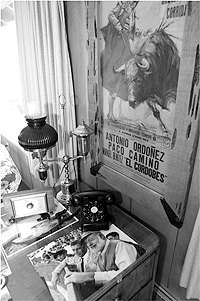 In Hemingway's master bedroom, relics of his life decorate the tabletops and walls. Some hearken back to the author's days in Spain, where he often attended bullfights. Express photos by Chris Pilaro
In Hemingway's master bedroom, relics of his life decorate the tabletops and walls. Some hearken back to the author's days in Spain, where he often attended bullfights. Express photos by Chris Pilaro
|
 print this page
print this page
by GREGORY FOLEY
|
In the Ketchum house where Ernest Hemingway took his last few steps, his last few breaths, reminders of the author's passions are in plain view.
In the living room, there are two African trophy heads and a box of old Remington shotgun shells, relics of days on the hunt.
Nearby, an empty bottle of fine Bordeaux wine sits on an encased shelf. It is from 1961, the year the Nobel Prize-winning writer took his own life just a few feet away.
In the stairwell, there is a strangely mesmerizing oil painting of a scene from a Spanish bullfight. The piece is signed by artist Waldo Pierce, who traveled with Hemingway in 1923 to Pamplona, Spain, for the Fiesta of San Fermin, the so-called "Running of the Bulls" festival made famous a few years later in the novel "The Sun Also Rises."
In the master bedroom, standing out among pieces of antique luggage and travel gear, there are photos of a bearded, gray-haired Hemingway with some of his beloved cats.
The most poignant reminder of Hemingway, perhaps, is an old Royal typewriter stationed in the second bedroom. It sits solitary on an elevated desk next to a north-facing picture window, before which Hemingway would stand and work as he gazed out over the Boulder Mountains.
"We think this house is a treasure," said Wilson McElhinny, a director of the nonprofit Idaho Hemingway House Foundation, a Ketchum-based group that hopes to restore the house and open it for limited public use. "It's a great location. It's a great site."
The Hemingway estate in northern Ketchum, which comprises the house and approximately 13 acres of land adjacent to the Big Wood River, was built in 1953 by Henry J. "Bob" Topping, an heir to a fortune that came from the tin industry.
Topping, whose five wives included actresses Arlene Judge and Lana Turner, had the house modeled after the nearby Sun Valley Lodge. Using a unique process similar to that used to construct the famous lodge, builders composed an exterior of poured concrete stained to resemble treated wood.
In the late 1950s, Topping and his fifth wife, Mona Moedl—an ice skater and ski instructor—moved to Arizona in pursuit of a warmer climate. Hemingway, who had been visiting the Wood River Valley since 1939, purchased the estate—complete with all of the interior furnishings—in 1959 for $50,000.
Many Hemingway scholars have maintained that the writer—a veritable man of the world—had only three places he ever considered to be his home: Key West, Fla., San Francisco de Paulo, Cuba, and Ketchum.
Hemingway's second wife, Pauline Pfeiffer, kept the couple's Key West house after they divorced. After his third marriage failed, the author married his fourth wife, a journalist by the name of Mary Welsh, in 1946 in Cuba.
Idaho Hemingway House Foundation directors—including Mariel Hemingway, the author's granddaughter—have noted that although Hemingway considered his Cuban estate, called the Finca Vigia, to be his true home, the wet, tropical climate was considered a threat to his extensive collections of manuscripts, letters and photographs.
A Hemingway letter written to a friend in 1959 noted: "The new place we have in Ketchum is fire proof with dry climate and (we) eventually hope to have all our pictures and manuscripts etc. there."
To another friend, Gen. Buck Lanham, Hemingway wrote: "This place ... was a wonderful buy. I plan to live here in the shooting months, which correspond to the hurricane months and the early northers in Cuba. My health and Mary's needs a change of climate from the subtropics for part of each year."
While residing at his Ketchum estate, Hemingway wrote portions of "The Garden of Eden," a posthumously published novel about a writer who struggles to emerge from a problematic love triangle, and "A Moveable Feast," a lively memoir of his early days as a writer in Paris.
Previously, Hemingway had written parts of his 1940 novel "For Whom the Bell Tolls," about the Spanish Civil War, while residing at the Sun Valley Lodge.
Suffering from depression and a variety of health ailments, Hemingway killed himself with a 12-gauge shotgun in the front room of the house on July 2, 1961. He was 61.
Hemingway was buried in the Ketchum Cemetery, immediately north of downtown.
Mary Hemingway lived in the Ketchum house until 1986, when she fell ill during a visit to New York. In her absence, she allowed The Nature Conservancy to use the house as the headquarters of its newly formed Idaho chapter.
Upon her death, Mary bequeathed the house to TNC, specifying that the property be used as a nature preserve and a nature-related reference library.
The acreage surrounding the house has been maintained in a relatively pristine state and is today the largest parcel of undeveloped land in the Ketchum city limits.
The house has been altered in places and has deteriorated somewhat. But as the Big Wood River relentlessly flows by, one needs little imagination to envision a scene from 45 years ago, of an elderly Hemingway standing in the great room, looking east toward the Sun Valley Lodge, contemplating the snow-capped mountains beyond.
Copyright © 2024 Express Publishing Inc. The
Idaho Mountain Express is distributed free to residents and guests
throughout the Sun Valley, Idaho resort area community.
Subscribers to the
Idaho Mountain Express will read these stories and others in this week's
issue.
All Rights reserved. Reproduction in whole or in part in any form or medium without
express written permission of Express Publishing Inc. is prohibited.